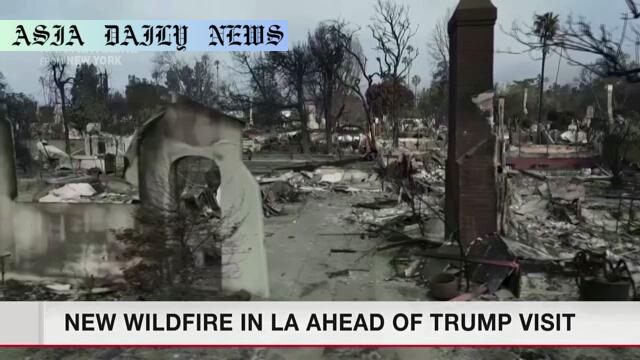Wildfire: A new wildfire in Los Angeles County has caused rapid evacuations, affecting over 50,000 residents and scorching 38 square kilometers in just six hours.
- A rapidly spreading wildfire in Los Angeles’ Castaic area affects over 50,000 people.
- Authorities report 28 fatalities with investigations ongoing into the cause of recent wildfires.
- President Donald Trump is set to visit the affected regions to survey the damage.
- Weather conditions with strong winds are likely to worsen fire conditions through Friday.

Introduction: Wildfire Crisis in Los Angeles
A severe wildfire has erupted in the Los Angeles County region, marked as one of the most critical crises the area has faced in recent years. Dubbed the Hughes Fire, it started in the Castaic area along the northern outskirts of the county on a Wednesday and has since spread at an alarming rate. Within just six hours, the blaze consumed approximately 38 square kilometers, severely disrupting the lives of residents and leading to large-scale evacuations.
The Immediate Impacts
Evacuation orders and warnings have been issued for over 50,000 individuals as flames encroach on residential zones. Local authorities face significant challenges in managing the situation due to the fire’s rapid spread and uncontrollable nature. As of now, 28 fatalities have been confirmed, with fire-related injuries and resource limitations compounding the tragedy. Emergency services, alongside firefighting units, are working tirelessly to minimize damages while ensuring the safety of impacted communities.
Ongoing Efforts to Contain the Blaze
While progress has been made in containing smaller fires in the Pacific Palisades and Altadena zones, these have yet to be fully extinguished. Firefighters face adverse conditions, including strong winds that could exacerbate existing flames and fuel new ones by Friday. Local and federal fire management teams are coordinating resources, drawing on both ground and aerial firefighting units to suppress the Hughes Fire’s unrelenting spread.
Presidential Attention and Investigations
President Donald Trump has announced plans to visit the stricken counties on Friday, aiming to survey the destruction and meet with survivors. While federal support is anticipated in the form of relief packages or resource allocations, the underlying cause of this wildfire—and the preceding incidents—remains under investigation. Law enforcement and environmental agencies are working collaboratively to assess whether these fires were prompted by natural events or human negligence.
Weather Warnings and Proactive Measures
Meteorologists have issued warnings of strong winds capable of further fueling the Hughes Fire and other hotspots in the area. They urge residents to remain vigilant and adhere to evacuation protocols where applicable. Public message campaigns advise communities to monitor air quality, seek shelter, and report suspicious activity to aid professionals with fire prevention efforts.
Broader Implications
The frequency and intensity of wildfires in California continue to raise global concerns about the broader impacts of climate change. Many experts are attributing this rise in extreme weather conditions to environmental degradation and inadequate mitigation strategies. This latest disaster serves as another reminder of the urgent need for structural reforms to forest management, increased investment in firefighting infrastructure, and collaboration between state and federal authorities to combat climate-based risks effectively.
Conclusion
The Hughes Fire is a stark reminder of the devastation that wildfires can unleash on communities. With thousands displaced, lives lost, and natural resources obliterated, efforts must be redoubled to protect citizens, mitigate fire risks, and address the environmental factors driving such catastrophes. The situation in Los Angeles remains dire, but with unified action across multiple stakeholder levels, recovery and rebuilding extend as attainable goals.



Commentary
Analyzing the Wildfire: Urgency and Lessons
The latest wildfire in Los Angeles highlights both the immediacy of the crisis and the long-standing challenges that accompany such natural disasters. What stands out in this instance is the speed with which the devastation unfolded—scorching 38 square kilometers in under six hours. This rapid progression emphasizes how critical early detection and prompt decision-making can be in minimizing harm.
Human Impact and Resilience
One cannot overlook the human toll of such events. Over 50,000 people are now left in a state of uncertainty, facing displacement, lost homes, and, in the most tragic instances, the loss of loved ones. The fatalities reported not only underline the destructive potential of wildfires but also illustrate the need for robust community safety protocols that can further save lives during emergencies.
Environmental Considerations and Future Focus
Conversations around the Hughes Fire must also bring environmental issues to the forefront. The recurrence of such events cannot simply be relegated to fate; they are becoming disturbingly common. Climate change-driven conditions, inadequate forest management policies, and limited firefighting capacities collectively demand attention. Policymakers and authorities must recognize these factors and move toward long-term reforms aimed at minimizing the risks posed to vulnerable regions.
The Way Forward
In the aftermath of this calamity, there will likely be conversations about rebuilding and recovery. While these are essential, equal emphasis must also be placed on prevention and preparedness. Investments in awareness programs, technological innovations in disaster management, and climate-conscious urban planning will be necessary to safeguard the future.